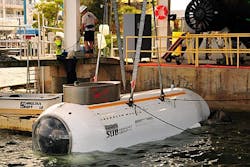Project moves ahead to develop mini-submarines for covert special operations forces
MacDILL AFB, Fla., 12 Dec. 2012. Leaders of U.S. Special Operations Command (USSOCOM) at MacDill Air Force Base, Fla., are moving ahead with a project to develop mini submarines able to transport combat swimmers such as Navy SEALs covertly while minimizing swim time to maintain combat effectiveness.
USSOCOM awarded a potential $44.3 million contract last Friday to submarine maker General Dynamics Electric Boat in Groton, Conn., for the Dry Combat Submersible-Light (DCS-L) program to build a user operational evaluation system of a mini-submarine designed to deliver combat swimmers. The contract was announced this week.
This kind of mini-submarine is intended to operate from combat support surface ships or submarines. These subsea vessels are to deliver special operations warfighters to their mission areas ready to fight, rather than exhausted by long swims.
The USSOCOM contract to Electric Boat is a three-year phase II research and development letter contract that calls for the company to design, build, test, and deliver a complete commercially classed prototype dry combat submersible system.
Electric Boat designers will do work on the contract in the U.S. and in Italy, USSOCOM officials say.
U.S. Special Operations forces have been planning a submersible combat swimmer delivery system since cancelling the organization's Joint Multi-Mission Submersibles program two years ago because it was too expensive.
Last April USSOCOM awarded a contract to the Lockheed Martin Corp. Mission Systems & Sensors segment in Palm Beach, Fla., to design a prototype Dry Combat Submersible (DCS) to transport Navy SEALs directly to their underwater mission areas.
The Lockheed Martin-led DCS team includes Submergence Group LLC in Chester, Conn.; Northrop Grumman Undersea Systems segment in Annapolis, Md.; and Huntington Ingalls Newport News Shipbuilding in Newport News, Va.
The USSOCOM projects seek to design and build prototype one-atmosphere special operations dry combat submersibles of two different sizes, light and medium, which will be free-swimming vehicles capable of delivering and extracting teams of combat swimmers.
USSOCOM officials are interested in dry combat submersibles that can move at speeds of at least five knots, at depths to 200 feet, with provisions for two pilots.
These dry submersibles should be sized to transport aboard C-5 or C-17 cargo jets, or in standard 40-foot surface ship containers. The submersibles are to have military radios, military sonars, and high power silver-zinc batteries.
These submersibles would operate from surface support ships or submarines equipped with pressure-proof shelter systems either military or commercial, or future generations of the Dry Deck Shelter (DDS).
The Dry Combat Submersible-Light will be about 24 feet long with moderate endurance and moderate passenger and cargo capability that will be operated from specially configured commercial surface ships.
The Dry Combat Submersible-Medium, meanwhile, will be about 38 feet long with high endurance and high passenger and cargo capability that will be operated from specially configured commercial surface ships, and potentially from future submarine shelter systems.
For more information contact General Dynamics Electric Boat online at www.gdeb.com, USSOCOM at www.socom.mil, or Lockheed Martin Mission Systems & Sensors at www.lockheedmartin.com/us/ms2.

